FLESHY SIMPLE FRUITS
 Tomato
Tomato
 Tomato can be eaten raw in salads or cooked as a vegetable and it is a common ingredient in soups and stews. Tomato is also used in sauces, pickles and chutney, which is often made from green tomato.
Tomato can be eaten raw in salads or cooked as a vegetable and it is a common ingredient in soups and stews. Tomato is also used in sauces, pickles and chutney, which is often made from green tomato.
HISTORY: Tomatoes are originated in the South American Andes. Earlier it is cherry sized and later grew wild. The name tomato meaning is poma amoris or "love apple" in Italian. It's tough to believe that this important ingredient of our diet was not that long ago considered poisonous, by Americans. Then, Robert Gibbon Johnson saving the tomato. In 1820, he ate a tomato by standing on the steps of a New Jersey courthouse and proved that they were harmless.
Hybrid Tomato plants maintains their popularity year after year. They are hearty producers and sometime combines the unusual characteristics of heirloom tomatoes with the ruggedness of conventional commercial tomatoes.
 Banana
Banana
 The structure of bananas looks like a long curving cylinder. The bottom end is narrowed to a point and the top end has a thick stem that attaches the fruit to the inflorescence stalk. A small group of bananas is referred as "hands". Many hands are collectively called as "bunches". Banana has smooth and thick skin and often has a few vertical ridges that run along the length of the fruit. The flesh of the fruit is in creamy white and soft.
The structure of bananas looks like a long curving cylinder. The bottom end is narrowed to a point and the top end has a thick stem that attaches the fruit to the inflorescence stalk. A small group of bananas is referred as "hands". Many hands are collectively called as "bunches". Banana has smooth and thick skin and often has a few vertical ridges that run along the length of the fruit. The flesh of the fruit is in creamy white and soft.
The fruit, which is technically referred as berry, changes from deep green to yellow or red, and the length ranges from 2-1/2 to 12 inches and 3/4 to 2 inches. The flesh, ivory-white to yellow or salmon-yellow, may be firm, astringent, even gummy with latex when unripe, turning tender and slippery, or soft and mellow or rather dry and mealy or starchy when ripe. The flavor may be mild and sweet or subacid with a distinct apple tone. The common cultivated types are generally seedless with just vestiges of ovules visible as brown specks. Occasionally, cross-pollination with wild types will result in a number of seeds in a normally seedless variety.
Banana is an energy booster, it contains tryptophan, a type of protein that the body converts into serotonin. Serotonin is a hormone that is known to make you feel happy and improve your mood, Banana is a rich source of iron, thus it is helpful in cases of anemia and Banana is good for people who have high blood pressure because it is low in salt.
 Grapes
Grapes
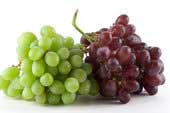 The grape is one of the oldest fruits to be cultivated going back as far as biblical times. Spanish explorers introduced the fruit to America approximately 300 years ago. Some of the most popular ways in which the fruit is used, is eaten fresh, in preserves or canned in jellies, dried into raisins, and crushed for juice or wine. Although, machines have taken the place of much handwork, table grapes are still harvested by hand in many places. (Wellness Encyclopedia of Food and Nutrition, 1992).Grapes are about 80 percent water, making them a delectable low-calorie snack or dessert; a cup of Concord or Catawba grapes contains only about 60 calories Grapes also add fiber to the diet and are naturally low in sodium. Raisins, or dried grapes, contain only about 15 percent water. For this reason, nutrients and calories are more concentrated in raisins-one cup contains 464 calories! Like other dried fruit, raisins are a good source of iron. Serving Size 1-1/2 cups.
The grape is one of the oldest fruits to be cultivated going back as far as biblical times. Spanish explorers introduced the fruit to America approximately 300 years ago. Some of the most popular ways in which the fruit is used, is eaten fresh, in preserves or canned in jellies, dried into raisins, and crushed for juice or wine. Although, machines have taken the place of much handwork, table grapes are still harvested by hand in many places. (Wellness Encyclopedia of Food and Nutrition, 1992).Grapes are about 80 percent water, making them a delectable low-calorie snack or dessert; a cup of Concord or Catawba grapes contains only about 60 calories Grapes also add fiber to the diet and are naturally low in sodium. Raisins, or dried grapes, contain only about 15 percent water. For this reason, nutrients and calories are more concentrated in raisins-one cup contains 464 calories! Like other dried fruit, raisins are a good source of iron. Serving Size 1-1/2 cups.
Grapes grow in clusters of 6 to 300, and can be crimson, black, dark blue, yellow, green and pink. However, "white" grapesare actually green in color, and are evolutionarily derived from the red grape. Mutations in two regulatory genes of white grapes turn off production of anthocyanins which are responsible for the color of red grapes.Anthocyanins and other pigment chemicals of the larger family of polyphenols in red grapes are responsible for the varying shades of purple in red wines.
Grapes come in more than 50 varieties in black, blue, blue-black, golden, red, green, purple, and white colors with a juicy pulp inside. The two main types of grapes are the American and European. They both come in seeded and seedless varieties. Common varieties include Thompson, Flame, Ruby, Perlette and Tokay grapes. Most U.S. grapes are grown in California.
 Drupes - Almond
Drupes - Almond
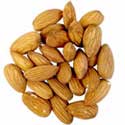 The almond is native to Iran, from northwestern Saudi Arabia.The sweet almond itself contains practically no carbohydrates and may therefore be made into flour for cakes and cookies for low carbohydrate diets or for patients suffering from diabetes mellitus or any other form of glycosuria.
The almond is native to Iran, from northwestern Saudi Arabia.The sweet almond itself contains practically no carbohydrates and may therefore be made into flour for cakes and cookies for low carbohydrate diets or for patients suffering from diabetes mellitus or any other form of glycosuria.
Almond flour is gluten free and therefore a popular ingredient in cookery in place of wheat flour for gluten-sensitive people, and people with wheat allergies and coeliac disease.
Almonds can be processed into a milk substitute simply called almond milk; the nut's soft texture, mild flavour, and light colouring (when skinned) make for an efficient analog to dairy, and a soy-free choice, for lactose intolerant people, vegans, and so on. Raw, blanched, and lightly toasted almonds all work well for different production techniques, some of which are very similar to that of soymilk and some of which actually use no heat, resulting in "raw milk".
 Plum
Plum
 Plums are hard-pitted fruits like peachs, cherrys, almonds, and apricots. About 12 plum species are cultivated throughout temperate regions for their fruit and as blossoming ornamentals.
Plums are hard-pitted fruits like peachs, cherrys, almonds, and apricots. About 12 plum species are cultivated throughout temperate regions for their fruit and as blossoming ornamentals.
The common European plum, the most important genus, has been cultivated since earliest times and probably originated near the Caspian Sea. It was introduced into North America, possibly by the Pilgrims, and is now mostly cultivated in the western United States, California in particular. Fruits of varieties of this species range in color from yellow or red to green, but purplish-blue is most common. Dried plums, or prunes, are made from the varieties that are richest in sugar and solids.
There are hundreds of plum varieties cultivated all over the world. All grow in clusters, have smooth, highly colored skin and a center hollow. Plums can range in shape from oval to round and in size from 1 to 3 inches in diameter. Their color can be yellow, green, red, purple, indigo blue and almost anything in between. The pale silvery-gray, filmy-looking coating on a plum's skin is natural and doesn't affect quality. in general, plums can be divided into two categories: Japanese and European. Japanese plums (which actually originated in China) are the larger of the two and have a juicier, softer flesh. European plums are good eaten fresh, but are particularly well suited to drying and cooking.
 Drupes-Peach
Drupes-Peach
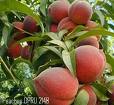 Peaches can be red, pink, yellow, white, or a combination of those colors. On one side of the fruit is a distinctive vertical indentation. Peaches and nectarines look very similar, but they can be told apart by their skin texture: peaches are fuzzy and dull, while nectarines are smooth and shiny.
Peaches can be red, pink, yellow, white, or a combination of those colors. On one side of the fruit is a distinctive vertical indentation. Peaches and nectarines look very similar, but they can be told apart by their skin texture: peaches are fuzzy and dull, while nectarines are smooth and shiny.
The peach has often been called the Queen of Fruits. Its beauty is surpassed only by its delightful flavor and texture. A tree-ripened peach is something to behold -- and better to eat.Bacterial leaf spot is prevalent on peaches in all areas of the state. Sprays are not effective against this disease. If severe, bacterial leaf spot can defoliate and weaken the trees and result in reduced yields and poorer-quality fruit. Peach cultivars show varying degrees of resistance to this disease.
 Pomes - Pears
Pomes - Pears
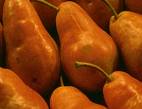 Pears are original from Europe and Asia. The first cultivated races were selected from the wild varieties in the prehistoric ages. Pear, common name for about 20 species of trees of a genus in the rose family, and for their fruit. The common pear is native to Europe; the Chinese sand pear is native to the Orient. Both species are extensively cultivated for their fruit in cool, humid, temperate regions throughout the world.
Pears are original from Europe and Asia. The first cultivated races were selected from the wild varieties in the prehistoric ages. Pear, common name for about 20 species of trees of a genus in the rose family, and for their fruit. The common pear is native to Europe; the Chinese sand pear is native to the Orient. Both species are extensively cultivated for their fruit in cool, humid, temperate regions throughout the world.
A superb new midseason pear that is ready to pick around the first week in October. Known as 'butter pear' as its velvety flesh lacks the grittiness found in some other varieties. For best results pick fruits whilst still firm and they'll store at least until Christmas. Bring them indoors as needed and they will ripen in a day or so when the rich aromatic flavour and delicious juiciness can be enjoyed to the full!
 Pomes-Apple
Pomes-Apple
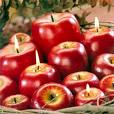 The apple is the pomaceous fruit of the apple tree, species Malus domestica in the rose family Rosaceae. It is one of the most generally refined tree fruits. The tree originated from Central Asia, where its wild forebear is still found today. There are more than 7,500 known cultivars of apples ensuing in range of desired characteristics. Cultivars differ in their yield and the ultimate size of the tree, even when grown on the same rootstock.
The apple is the pomaceous fruit of the apple tree, species Malus domestica in the rose family Rosaceae. It is one of the most generally refined tree fruits. The tree originated from Central Asia, where its wild forebear is still found today. There are more than 7,500 known cultivars of apples ensuing in range of desired characteristics. Cultivars differ in their yield and the ultimate size of the tree, even when grown on the same rootstock.
At least 55 million tonnes of apples were grown worldwide in 2005, with a value of about $10 billion. China produced about 35% of this total. The United States is the second leading producer, with more than 7.5% of the world production. Turkey, France, Italy and Iran are among the leading apple exporters.
Apples, as eaten in the fresh state, are a healthy uplifting, crunchy snack. They quench your desire and their acid content makes them a natural mouth freshener. To bite into a fresh picked apple is a memorable experience. The juice is honey sweet and spicy tart at the same time and the flesh is fragrant and crisp.
The Greek and Roman mythology refer to apples as signs of love and beauty but Apple contain vitamins like Vitamin C, Beta-Carotene, iron and potassium etc., The Vitamin C pleased may not be as good as Oranges but apples have very high mineral contents, pectins, malic acid which are good in normalizing the intestines. Apple is good for handling of anaemia, dysentery, heart disease, headache, eye disorders, kidney stones and promotes strength and energy. Apple juice is good to overcome a liverish feeling, further, apples are not likely to cause allergic reactions and are excellent means of providing essential fluids to the body.















